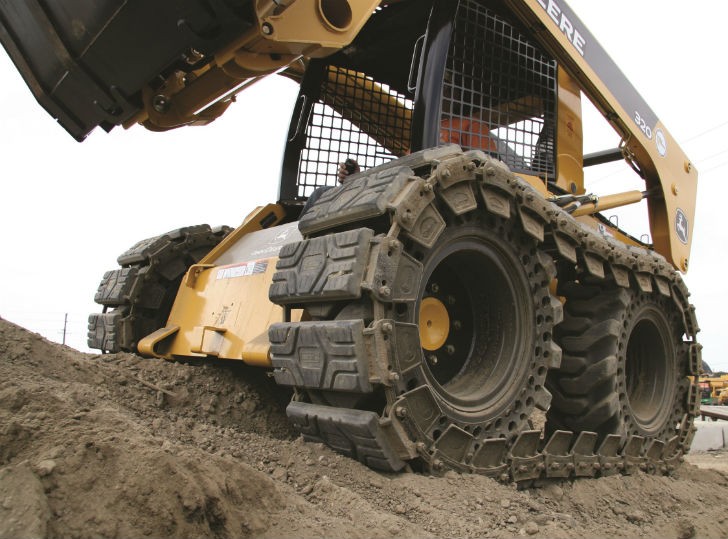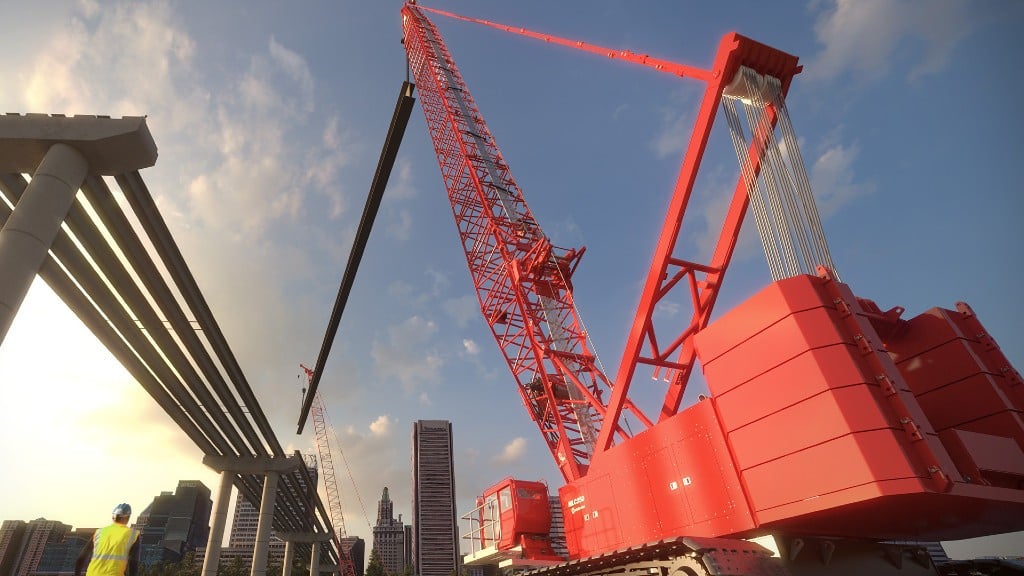Adding Tracks to a Skid-Steer Loader
Understanding materials, styles, sizes and features will get you on track to making the best choice

Wouldn’t it be great if your skid steer always had perfect traction, never damaged turf or asphalt and didn’t bog down in sloppy conditions? Tracking down the best solution for a skid steer can be tiring: should it be tracks, tires or both? Tracks give the best traction. Tires provide the most comfortable ride. Is it worth paying more to have both capabilities?
The answer isn’t that straightforward. Different applications have different needs. Sometimes steel tracks are best, sometimes rubber. On other occasions, tires are the better option. It’s important to look at the way the skid steer is used over time. If jobs always involve flat asphalt, tires should work fine. If a skid steer only operates on a golf course turf, rubber tracks would be best. Oftentimes, though, a skid steer moves among varying jobsites – or even a single jobsite with varying terrain – from asphalt to dirt to a steep, grassy hill.
When variety is part of the job, overthe- tire tracks provide the most versatile option. Understanding materials, styles, sizes and features will get you on track to making the best choice for your skid steer.
Tracks: facts and benefits
Pneumatic and semi-pneumatic tires offer a comfortable, cushioned ride that minimizes damage to the machine’s components while tracks provide better traction and less damage to the ground surface. A skid steer’s stability improves with tracks, which lower the machine’s centre of gravity. Additionally, tracks offer greater stability than tires when operating on the side of a hill.
Tracks also help prevent punctures in pneumatic tires, a major source of downtime for some contractors. Coupling tracks with semi-pneumatic tires – which are air-cushioned yet flatproof – provides an additional level of puncture resistance. In essence, over-the-tire tracks bridge the gap between tires and tracks, attempting to offer the best of both configurations.
Steel or rubber or both
When it comes to over-the-tire track materials, there are benefits to both steel and rubber, dependent upon application. Plus, there are variances to both, with three basic types of steel and two basic rubber versions on the market.
Steel track options include steel pad, steel bar and light duty. Enclosed steel pad, or closed bar, tracks provide good traction and flotation. Steel pads can handle a variety of applications but are ideal for construction industry jobsites.
Steel bar, or cross bar, tracks can handle the most aggressive terrains. Each cross bar is open so that material can flow through the tracks and increase pressure on each contact point. This helps provide the greatest amount of traction, making steel bar tracks well suited to hilly terrain and land-clearing applications.
The least expensive style of steel tracks, light-duty tracks, are not used regularly since excessive hours cannot be put on them. Light-duty tracks work best for skid steers that rarely operate on challenging terrain, such as those used for farm, residential or industrial applications. Each option’s price reflects the versatility and amount of use for which each was built.
No matter the style, steel tracks can be too aggressive for turf and concrete or asphalt surfaces. While many operators claim that steel tracks will still manage turf more gently than tires, rubber tracks are the best option for this type of work. Additionally, when a skid steer is being used for landscaping operations in a residential area, rubber tracks will eliminate any noise that might be associated with steel tracks.
Rubber tracks cost slightly more than steel and come in two basic designs: friction and tension. Friction tracks provide the greatest versatility while putting little stress on the skid steer’s axles. By contrast, tension tracks fit tighter, which can put strain on the axles. Tension tracks also take considerably longer to install than the 30-minute process for friction track installation, making tension tracks more of a permanent solution than an interchangeable option.
For even more versatility, over-the-tire tracks are available with a combination of steel and rubber construction. The strength and durability of the steel is enhanced with rubber pad inserts, which allow them to maneuver on more delicate surfaces while still handling aggressive, challenging terrain. Should a job require working on rocky areas, which can be damaging to rubber tracks, the rubber pads can be replaced with steel pads. As noted with steel tracks, price rises with increased durability and versatility. The ability for these tracks to go almost anywhere ranks them among the most expensive options.
The right size matters
Before renting or purchasing steel, rubber or hybrid tracks, take some measurements to ensure the tracks will fit the skid steer. Check the tire width and the wheelbase. With those measurements, a track manufacturer will be able to match a set of steel or rubber tracks, which both fit the same when it comes to sizing. The bulk of tracks used on skid steers will be in the 10- to 14-inch width range.
Since tracks’ function includes protecting the tires, using the wrong size literally could stop a skid steer in its tracks. Small tracks on larger tires, or vice versa, will lead to unprotected tires and excessive track wear. Using the right size will lessen maintenance concerns and prolong the life of both the tracks and tires.
Features that extend track life and save money
When investing in over-the-tire tracks, it only makes sense to look for features that will extend the service life while easing maintenance concerns. For instance, parts that can be easily repaired or replaced will save money in the long run since fixing and replacing components as they wear will be significantly less expensive than purchasing replacement tracks. Especially look for replaceable pins and links – the main wear parts on tracks.
Strong, durable materials will also contribute to a track set’s longevity. With steel tracks, look for traction parts with steel alloy rather than cast iron. The steel will be more durable while weighing the same as cast iron so there are no negative effects on the drivetrain. Additionally, look for links and pins made with forged, enriched steel for added durability.
Parts are money but so is time. Look for tracks that can be quickly installed over the tires and easily removed as well. The less time spent changing between tires and tracks means more time spent on the project and the greater the productivity level and profit.
Some over-the-tire tracks feature a self-cleaning design, which will also contribute to the system’s longevity. This configuration allows debris that gets under the tracks to be expunged from the track and tire area.
It’s also important to ensure that only pneumatic or semi-pneumatic tires are used under tracks. If pneumatic tires are used, they must be properly inflated. Without the flexibility that these styles provide, the tracks will wear at an excessive rate. Additionally, any debris caught between a stiff tire, such as one that’s solid rubber, and the tracks will cause problems. Both materials are rigid and something will need to give, either the tire, track or axle.
When used in the right combination, over-the-tire tracks provide some of the greatest diversity on the jobsite. After all, an operator can’t add tires to a track loader when an application would be best suited for wheels. A skid steer with over-the-tire tracks, however, can easily move among varying applications, ensuring a best solution to any situation.
This versatility can increase profit as more job applications become feasible. The worries of fines for damaging a surface with the wrong tires or tracks will be diminished, as well. There’s no reason to end up in a bind on a jobsite. Over the tire tracks come in a variety of styles and materials to handle nearly any situation.
For more on skid-steer loaders, check out Heavy Equipment Guide's in-depth report on skid-steer loaders.



